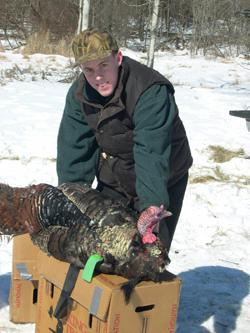Winter Distribution Analysis of Wild Turkeys Surrounding Pease Tradeport

From November 2006 through April 2007, wildlife management major Orrin Jones investigated the winter distribution of wild turkeys surrounding Pease International Tradeport.
In 2003, an Air National Guard military refueling tanker struck a wild turkey, which caused over 3 million dollars in damage to the aircraft. Since this accident, Tradeport personnel have increased surveillance and attempted deterrence of wild turkeys from the airfield. The goal of Jones’s research, funded by an Undergraduate Research Award (URA), was to provide important biological information that could help predict wild turkey movements and distribution around Pease, and be used to prevent bird strikes by aircraft.
By employing the use of Geographic Information Systems (GIS), Jones collected the locations of 15 turkeys that were radio-marked in February 2006, tracked their movements, and measured the effect of supplemental feeding on winter distribution, fall and spring dispersal patters, and affinity for the Pease area. The area studied included rural agricultural land, the Great Bay National Wildlife Refuge, and residential and industrial areas.
During the first half of the winter season, weather was mild and ground forage was ample; as a result, the turkeys displayed wide-ranging movements and locations. From late January through early April, snow covered the ground and temperatures were much colder, forcing turkeys to take advantage of supplemental feed sites. Jones concluded that some of the possible consequences of cold weather and snow cover include an increased tolerance of people by turkeys, resulting in an increase in poaching; aggressive turkey behavior toward humans; and greater chance for collisions.
Jones was mentored by Dr. Peter Pekins of the Natural Resources Department.
